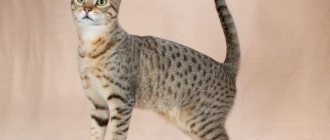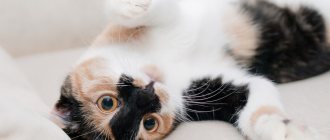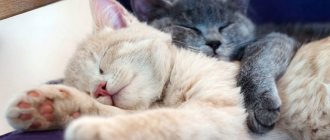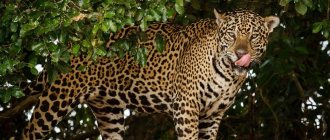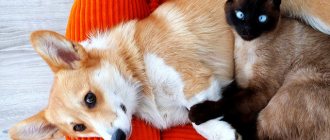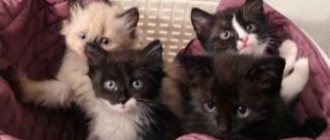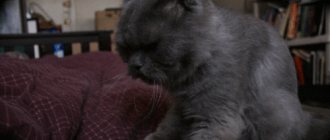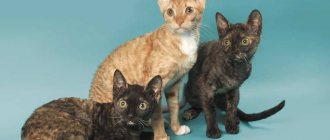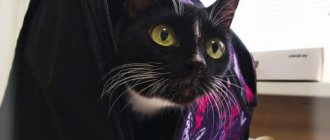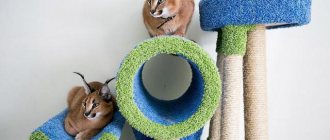Genetics of tabby cat color
Tabby color, i.e. The coat pattern, of which the mackerel (tiger, striped) is a subspecies, is caused by the dominant T gene (Tabby), located on chromosome 1B. Of all the mammals living on our planet, it is characteristic only of the cat order.
This color is also called wild, since the very first cats on earth had it. It is characterized by the fact that darker spots and lines are located on a light background.
There are four types of such colors based on the phenotype of the dominant gene (allele):
- Tm - tiger pattern or mackerel, i.e. pure striped;
- Tb - marbled color, classic;
- Ta - agouti, ticking (in Abyssinian cats);
- Spotted Tabby (spotted tabby) - a spotted pattern, this is a polygenic color, a combination of several genes is responsible for it.
All cats, without exception, are carriers of the T gene, but if a recessive gene that blocks ticking (non-Agouti) is present in the animal’s phenotype, then the stripes are not visually visible.
Following in the footsteps of forest animals
If you go out to the edge of a Siberian forest on a sunny summer morning, the first living creature that meets you will most likely be a chipmunk. This small cheerful animal with a striped back will flash among the windfall or dense underbrush, with a sharp whistle it will fly up the trunk of the nearest tree to the first knot and, trembling its tail, will examine you with curiosity. In appearance and lifestyle, the chipmunk resembles both a squirrel and a gopher. Like a squirrel, it lives in the forest and climbs trees, but like a gopher, it grows holes and hibernates for the winter. In size, this animal is inferior, however, to both the squirrel and the gopher. Its body length is 13-17 centimeters; a little more than half of the body is a fluffy tail, as if combed in the middle; weight approximately 100-110 grams. The general color of the fur is grayish-yellow. There are five brown or black longitudinal stripes on the back. The tail is black on top and red on the underside. Unlike the squirrel, it does not have ear tufts. The chipmunk inhabits all taiga forests of Siberia and the Far East, except Kamchatka. Through the Northern Urals, it penetrated into the European part, where it inhabits forest areas up to the middle part of the Vologda and northern parts of the Kostroma regions. This animal is a typical taiga inhabitant, but it avoids the dark coniferous taiga. It prefers forested areas with more light: forest edges, birch forests, pine forests, old overgrown burnt areas, forests of river valleys, forested mountain slopes with rocky outcrops, which it inhabits up to the upper border of the forest. The chipmunk is diurnal. He is very mobile, active and therefore often catches your eye. The animal feeds on seeds, berries, fruits, stems, leaves and flowers of more than 60 species of different trees, shrubs and herbs. Few people know that his diet also includes animal feed. The chipmunk regularly eats insects, their larvae and pupae, and sometimes even mollusks, small frogs and passerine eggs. Residues of animal food were found in more than half of the stomachs of chipmunks examined in Western Siberia. The animal’s refuge is a hole, which it digs somewhere under a windbreak. It is of a simple design, has one exit, and in the depths, sometimes half a meter from the surface of the earth, a large chamber in which the chipmunk stores up to 10 kilograms of various food for the winter. He spends the second half of summer and autumn creating these reserves. In its cheek pouches it carries up to 15 pine nuts at a time, i.e. about 10 grams of food.
In the belt forests of the Altai Territory, I saw chipmunks storing viburnum seeds, which they carefully cleaned from the pulp of the berries, and on the eastern slopes of the Sikhote-Alin I found in their storerooms the seeds of various herbs and dried rose hips. But the main food for this rodent in the Siberian taiga is pine nuts. Thus, it is a serious competitor to squirrel and sable. Where agricultural land adjoins the forest, chipmunks visit fields and vegetable gardens, sometimes moving up to a kilometer away from the forest edge. In such places, more than two or three kilograms of pure cereal grains and sunflower seeds were found in the chipmunk's pantries.
When snow falls, the animal goes into hibernation for the entire winter. He sleeps soundly. If you put a sleeping chipmunk in your palm, your skin feels its cold body. However, after a few minutes, the warmth of the human body warms the animal. The eyelids tremble, then the slits of the eyes open, and he begins to move. In early spring, with the appearance of the first thawed patches and the onset of warm sunny days, chipmunks begin to emerge from their holes. But there is no food in the forest yet, and the animals exist only at the expense of their reserves. At this time, their mating season begins. Several males chase after one female. After a month’s pregnancy, the female brings from four to ten cubs. 3 age 30-40 days The young leave the parental burrow and begin to lead an independent life.
The animals reach sexual maturity at the age of 10-11 months. The chipmunk has many enemies. It is hunted by all mustelids, foxes, raccoon dogs, and diurnal feathered predators. Even the bear digs up the holes of these rodents for the sake of abundant supplies. The chipmunk leaves few traces of its activity. Yes, this is understandable, if you take into account its size and six-month hibernation. Sometimes you can find its burrow, gnawed cones or paw prints, very similar to those of a squirrel, but much smaller, which it leaves on the last spring. All these tracks have no practical significance, since the animal indicates its presence in the grounds by whistling and great mobility. The chipmunk is a commercial animal. It belongs to the “summer” fur-bearing species and is caught in the first month after emerging from hibernation, until it begins to molt. In areas where forests inhabited by the chipmunk move with agricultural lands, it can cause significant damage to grain crops. In such places, the number of animals should be reduced by intensive spring fishing.
Feature of striped color
In order for a cat to be tabby, in addition to the tabby gene, its chromosome set must also contain the Agouti ticking gene. In all such cats, each hair is colored in several dark and light shades, arranged in alternating patterns. Visually, this is perceived as lines and spots on the coat.
All ginger cats must have a striped pattern. The red color gene O, linked to the male chromosome X, suppresses the action of the recessive non-Agouti gene.
The tabby pattern can be tortoiseshell (tortie) cats and color-point animals.
Recent scientific research conducted by the famous geneticist Stephen O'Brien has led to the conclusion that the dominant T gene and the cat's immune system are related.
“A tabby is not a simple set of stripes and spots, it plays a more important role in a cat’s body” - this statement by the scientist formed the basis for his study of the relationship between tabby and animal immunity at the Scientific Center for Genomic Bioinformatics in St. Petersburg.
A distinctive feature of tabby cats is the letter “M” on their forehead. There is a biblical legend that it means the name of the Virgin Mary, since the mother of Jesus Christ stroked the head of the kitten lying next to her in the stable of Bethlehem on the night of the birth of the son of God.
Muslims believe that this is the first letter of the name of the Prophet Muhammad, since he loved cats very much.
Black and white zebra stripes are needed for heat transfer
While tracking two zebras, a stallion and a mare, the researchers noticed a difference in the temperature of the black and white stripes - something other scientists had previously observed. According to biologists, temperature differences help maintain an animal's body temperature at an optimal level by creating convective air movements. However, the Cobb couple made a new discovery.
By measuring the body temperature of a dead zebra, they found that if the same striped coat was present, it would have a higher temperature - a clear sign that other processes are also involved in thermoregulation. According to the researchers, heat regulation only works in living zebras because they have the amazing skill of raising the hair on the black stripes while leaving the white stripes flat. They are sure that this is what helps them remove excess heat from themselves.
Alison Cobb in Nairobi, 1991
Also in thermoregulation, the method of sweat removal plays an important role - all moisture from the skin is transferred to the ends of the hair in the form of foamy drops, which evaporate much faster than ordinary drops of moisture.
The mechanism of heat regulation in the zebra's body is a much more complex and interesting process than we could imagine. To fully understand how stripes help zebras control their temperature, we still have a lot of evidence work to do,” said Alison Cobb.
TOP 14 most striking representatives of the striped color
Almost all cats are tabbies, except for breeds that have a solid or solid color. These are Chartreuse, Russian Blue, Nibelung, Bombay cat, Balinese and some others. There are breeds that are bright representatives of the striped color.
Toyger
This breed is essentially a subspecies of the Bengal. For a Bengal cat, the merging of spots into continuous stripes is unacceptable and serves as grounds for disqualification.
The consolidation of this culling factor led to the formation of a new cat variety with a brindle pattern. In English-speaking felinology it is called mackerel.
This strong and energetic pet is no different in personality from the Bengal.
Read more in the article about toygers.
European Shorthair
Celtic cat is the second name of the breed. This naturally occurring variety has a strong, muscular body. He has a calm and friendly character. It is undemanding in maintenance and care.
Siberian cat
Animals with a strong and powerful body and a luxurious fur coat with undercoat are carriers of a very healthy immune system. This natural breed was formed in Siberia over many centuries.
Wonderful hunters and home protectors with a variety of numerous colors are always tabbies. They are distinguished by stripes on the paws and tail, round spots on the stomach and a clearly drawn letter M on the forehead.
By nature, these are very calm and serious animals that do not like excessive care. Long hair requires some care, especially during the shedding period.
Read more in the article about Siberian cats.
American Shorthair
These cats, which descended from their European counterparts, came to America with the first settlers. Adapting to new, harsh living conditions, the animals became larger in size and stronger, more muscular. The American coat is coarser and denser, with a well-developed undercoat.
The colors are varied - solid, shaded and tabby. The most famous, beloved and widespread type is the American cat with a classic marbled color.
These sociable but independent pets adapt well to any living conditions. They are smart and easy to train. They obey their household members and consider it their duty to care for and protect everyone living in the house.
The short and dense coat requires virtually no maintenance. The health of these cats usually does not cause any concern to owners.
Also read the article about American Shorthair cats.
Bengal
These hybrid animals always carry the Tm or Tb allele. Polygenic combinations produce the spotted tabby color. All cats have bright stripes and spots on their bodies, paws, tails and bellies. In this case, the main background can be different - gold (red), silver (gray), white (snow colors), black (black).
Bengal is a very mobile and active animal. Attached to the owner, an eternal child who will play all his life. Suffering from loneliness.
If it is not possible for one of the household members to always be in the house, then it is better to get another pet with the same lively and restless character.
The Bengal owes its dazzlingly beautiful coat with soft shiny fur to its wild ancestor - the Asian leopard cat (or Lesser Asian leopard). ALC, along with Ocelot and Margay, is the most striking representative of the tabby color in the world of wild cat species.
American Bobtail
The breed originated in the United States of America. Her ancestor was a homeless tabby kitten from the Arizona Indian Reservation.
These short-tailed animals come in different colors and types, but the tabby pattern remains the most common and beloved.
The character of the pets is calm and flexible. At the same time, they retain their love of freedom and independence. Smart, intelligent, even trainable. They are unpretentious in care and nutrition.
Read more in the article about American Bobtails.
Cymric
The long-haired beauty is distinguished by complete taillessness and a strong, muscular, fairly large body.
The double coat has a powerful undercoat, so the animal visually appears even larger. Comes in various colors. But tabby coloring is the most widespread.
These hardy, loyal and affectionate animals will never allow themselves to offend children. They are one of the best breeds for home keeping.
More about the Cymrics.
Soukok or sokoke
A small cat with a dry type of muscles is the bearer of a special unique color, which is called “soukok-tabby”.
This natural breed was discovered in Kenya, in the town of Soukok.
The color variations of the wool are varied, but the pattern is always marbled, in the form of large rings and “rosettes” of various sizes.
As a domestic variety, it is still a very young breed. Only twenty animals are registered in the fifth generation.
Good-natured pets are very active, cheerful and restless. Lovers to “talk” and play, are very smart and independent. They get along well with everyone, but it is better to have a cat of the same breed as a companion. They need large spaces to play and love to swim.
Read more in the article about the Sokoke breed.
Maine Coon
A native breed from the American state of Maine, it is distinguished by its large size, long, dense coat with a well-developed undercoat and independent character.
There are many legends about the origin of the variety. Maine Coon literally means “raccoon from Maine.” The second most popular breed in the United States.
The colors of the long coat can be different - solid, smoky, tortie and tabby. Although there are experiments on breeding coons and color-point colors, the so-called Si-coons.
These animals are calm, reserved, self-confident, independent, but good-natured. They require daily care and increased attention to health.
Norwegian forest
A strong and robust animal with a characteristic and recognizable body shape. Good health, excellent muscles and a long double coat with water-repellent properties are what allowed this cat to survive and adapt to the harsh Scandinavian climate.
This is the only cat that can climb down a tree trunk with its face; no other domestic breed has such powerful claws.
Tabby is one of the most common colors of the Norwegian.
The character is calm and reserved. The animal does not tolerate loneliness well and becomes strongly attached to humans.
Exotic
The exotic cat's body structure is completely reminiscent of the Persian. This breed was bred as its short-haired variant.
Among the many colors of Exot, tabby is very popular and loved.
These calm and unpretentious animals are generally recognized throughout the world as the most affectionate and loyal. The best pet option for families with children.
Asian tabby
The breed was artificially bred in the 1980s. The color of the coat can be different - black, red, chocolate, blue, cream, lilac, caramel, apricot. But the color is only tabby.
Calm and good-natured pets are very sociable and devoted to people. They get along well with any animals and are quite silent.
Pixiebob
This young variety is gaining worldwide popularity every year. First of all, because of his wonderful character. Although the exotic appearance also matters.
Pixie means “fairy-tale elf” - that was the name of the first representative of the breed. Bob - short ponytail.
These are animals with the appearance of a lynx and the character of an angel.
Active and energetic pets are completely unobtrusive and at the same time pathologically devoted to their owner. Very smart, inquisitive and sociable. They can easily learn to perform simple commands.
Read more in the article about pixie bobs.
British breed
British dogs come in different colors - both solid and tabby. Striped colors are very diverse in their color variations. They are divided into marbled, brindle and spotted (spotted) type according to the nature of the pattern.
Cats have the character of true English lords, they are very reserved, independent and proud.
We also recommend reading the article about British shorthair, longhair and fold cats.
1111
Do you know which animals have stripes?
There are not so many striped animals. You can count only about 30 species with a similar coloration. Of course, the first animals that come to mind when searching for an answer to the question of which animals have stripes are our pets – cats. In the cat family, several other species fall into this category.
Striped animals
1. Tigers. Their fur is 11 cm long in winter, and only 2 cm in summer. These are very large animals, their body length reaches 3 meters.
2. Ligers. There are other animals of the cat family that have a similar color. They are called ligers (a hybrid of a tiger and a lion). These are very large and heavy animals, weighing twice as much as a lion.
3. The musky cat, which lives exclusively on the island of Madagascar, has nothing in common with the cat family. This ferocious animal is a small civet from the civet family. It is “lined” with black and white stripes from head to paw tips. But the most valuable thing about this animal is its aromatic musk, which is produced by special glands and is used by local residents in perfumery.
4. Catta lemurs are also sometimes classified as lined felids when answering the question of which animals have stripes. Perhaps this is due to the fact that they have a similar color. However, they are, in fact, closer to monkeys than to cats. This is the most interesting animal with a striped tail, which is their information organ.
5. The striped hyena lives in both North Africa and Asia. This is quite a large animal. Hyenas weigh about 60 kg and are 90 cm tall. They prefer a nocturnal lifestyle and are scavengers, for which noble lions and tigers simply hate them.
6. Raccoon dogs. These animals are rarely remembered by anyone when thinking about the question of which animals have stripes. This animal looks like a striped raccoon, but they are not even related. He has a kind of “mask” on his face, and the rest of his body is covered with stripes.
7. Raccoons are also classified as “mustachioed-striped.” They are rightly called the cleanest animals, because before eating the food they have caught, they rinse it thoroughly in water. Scientists still have not been able to understand where this habit comes from.
8. How can one forget about zebras when answering the question of which animals have stripes? These are the most famous of the striped animals.
9. Couscous. Small animals living in Australia. They are related to possums. They can hang on trees for hours, even fly from branch to branch.
10. Mongoose. Who doesn’t remember the legendary Riki-Tiki-Tavi - the hero of Kipling’s fairy tales? This is a small animal that lives in India, which actively fights snakes and also has a striped color.
11. There are also birds on the list. The tawny owl is a barred owl with a long tail and an unusually loud voice. She lives in North America.
12. The striped rattlesnake is a snake with a so-called rattle on its tail, which consists of rings resulting from molting. This is a very fast and poisonous snake, but also very lazy.
13. The striped tenrec is very similar to a hedgehog. It has a very small size - 15 cm. These animals live in Africa.
14. Meerkat. Children and adults will probably remember the character from the cartoon “The Lion King” - Timon. This is the meerkat - a striped animal that lives in the Kalahari Desert.
15. Monitor lizards resemble dinosaurs. So, among them there is also a striped species. These are very large semi-aquatic animals. Their skin is used as raw material for making various accessories.
16. Striped animals also include black and white skunks, which live in North America.
17. The marmoset is the smallest monkey in the world, with a body length of no more than 12 cm, and its tail is 15 cm. It can also be striped.
18. There are many fish with a similar color, for example, zebra lionfish, barb and others.
